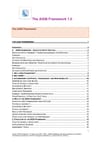🧩 Quick Summary
The AIGN Framework 1.0 is a comprehensive, operational governance model designed to make responsible AI tangible. Developed by the Artificial Intelligence Governance Network, it translates principles into tools, and risk into structure. It’s modular, maturity-based, and explicitly geared toward implementation across sectors, system types, and resource levels.
📌 What’s Covered
- Modular Governance Architecture: Built around Trust & Capability Indicators, Governance Maturity, Risk & Impact Mapping, Compliance Readiness, and Sustainability.
- Tools & Templates: Includes Trust Scan, AI Readiness Check, Education Trust Label, and Agentic Risk Assessment Tool (ARAT).
- Practical Integration: Maps to NIST AI RMF, OECD AI Principles, UNESCO Ethics, and the EU AI Act with plug-and-play implementation guidance.
- Low-resource & Global South Adaptability: Offers simplified governance kits for SMEs and non-Western regions.
- Agentic AI & Technical Governance: Covers incident response, red teaming, traceability-by-design, and explainability metrics by system type.
- Education Module: Curriculum mapping, stakeholder surveys, student voice mechanisms, and certification roadmap.
- Certification Logic: Structured around transparency and accountability rather than perfection—Trust Labels, Education Labels, and Engagement Certificates.
💡 Why it matters?
This isn’t another policy whitepaper. AIGN bridges the chasm between legal mandates (like the EU AI Act) and technical operations (like MLOps). It’s immediately usable by startups, enterprises, and public sector actors seeking a structured, auditable path toward AI trust. It brings a long-missing element to the governance ecosystem: usability. And crucially, it tackles sustainability, agent autonomy, and global inclusion not as extras—but as governance essentials.
🔍 What’s Missing
- Real-world benchmarking data: While use cases are offered, broad industry validation is still anecdotal.
- Legal enforceability: The framework aligns with laws but doesn’t yet have formal regulatory recognition.
- Granularity in some templates: Several tools like redline canvases or escalation matrices are conceptually strong but need further productization for plug-and-play deployment.
🧠 Best For
- Policy teams designing national or institutional AI strategies
- AI ethics officers and GRC leads seeking integration frameworks
- Public sector actors needing light-touch but credible governance pathways
- Educators embedding ethics into technical curricula
- Startups targeting EU or Global South trust markets
🏷️ Source Details
Title: The AIGN Framework 1.0
Author: AIGN – Artificial Intelligence Governance Network (Patrick Upmann, Founder)
Date: June 2025
Publisher: Travel+Feel magazine publishing e.K., Munich


